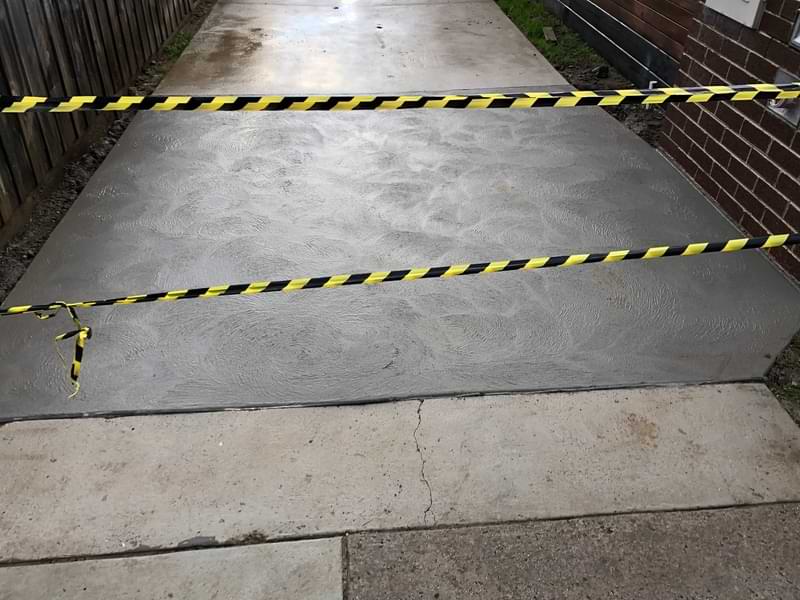Concrete is a surprisingly complex material and one of the most surprising things about concrete is that, despite looking as solid as a rock, it shrinks. Shrinking is an unavoidable feature of concrete but can also be the most damaging. It takes experience, proper technique and procedure to manage shrinking. At JMC Concrete, we’ve over a decade of experience in construction, eight years alone specialising in concrete. We know what shrinkage is, why it’s so damaging and the things needed to be done to manage it.
Why Does Concrete Shrink?
Shrinkage is part of the concrete process. It’s the result of moisture leaving the concrete and the aggregates (the little chunks that make up concrete) binding together, like a piece of clay left in the sun. This means that steps must be taken to properly manage shrinking and ensure it doesn’t lead to problems.
There are many types of shrinkage and a myriad of influences including weather, and a slab’s size, constituents and aggregate size. However, the main cause of shrinkage is poor reinforcements and poor mixtures. That’s why it’s so important to have reliable honest professionals that know what they’re doing.
What Can Happen If a Slab Shrinks?
Cement, when mixed with water, works like a glue holding all the aggregates together. As aggregates act like sponges, they absorb the water that goes into the mixture, sucking the cement towards them.
If concrete doesn’t have enough water, or dries too quickly, or isn’t properly reinforced, then all the aggregates start pulling at each other, over-shrinking the concrete. This increases the tensile stress on the concrete and, like pulling too hard on a rubber band, can tear the concrete apart. This can form especially damaging cracks that can extend through the whole slab of concrete and cause water to enter, impairing its durability. If the shrinkage is bad enough whole chunks of concrete can break off or the concrete can separate into blocks. This is why it’s so important to find a concreter who knows what they’re doing and what to look out for to control shrinkage.
How to Minimise Shrinkage
Use Reinforcements
A must-have for minimising concrete shrinkage is reinforcements. Reinforcements improve tensile strength, reduce shrinkage and prevent cracks from appearing. Your concreter will use either welded wire reinforcing fabric, trench mesh or steel reinforcing rods. They will also make sure the reinforcements are clean as any loose rust, paint, or oils mean your concrete won’t bond with the reinforcements. This can mean your concrete may be more affected by shrinkage.
Install Reinforcements Correctly
As many hands make light work, many correctly laid reinforcements control shrinkage. For a start, the reinforcements shouldn’t be placed on the ground. If they are, they’ll be exposed to rust and may disintegrate and your concrete may start over-shrinking. A reinforcement support called a bar chair, spaced no more than 800mm apart — roughly a stride or step — should be used to keep the reinforcements off the ground.
Further, reinforcements should be overlaid at least 500mm — about the length of two bricks —to properly distribute tensile stress that causes shrinkage. If your concrete has a junction or turn, like a T or an L shape, then there should be more overlaps in these areas.
Pour The Concrete Correctly
When the mixture is poured it should be fairly smooth, without large aggregates. If the aggregates are too large, bigger than 20mm — about the size of your fingernail — they will reduce the amount of water in the mixture and cause the concrete to shrink more.
In order to check there’s the right level of moisture in the mixture, a slump test will need to be done. A slump test is where a rod is inserted into wet concrete and pulled back out. It measures the workability, or consistency, of freshly mixed concrete, like a baker making sure their bread is perfect. Some of the concrete will come out with the slump, but not too much. If the concrete stays in perfect shape or doesn’t slump down, then the mixture may be too dry and lead to shrinkage after it’s been poured.
Once the concrete’s been poured, it’s going to need to be vibrated. Vibration makes sure the concrete binds with the reinforcements, reducing tensile stress. Over-vibration though can cause issues too, like honeycombing, so it’s good to ask when your concreter knows the vibration process is done.
Cure the Concrete
Once the concrete is laid and starts to dry, curing is the process that will stop it from shrinking too much and causing cracks. Curing is controlling the rate of moisture loss from the concrete. It involves constantly wetting the concrete as the surface dries faster than the rest of the concrete. If the top dries too early, the rest of the concrete can’t settle as well as it should. Then tensile stress develops, and cracks can occur. Further, if the top dries too fast the entire top layer can split off in a process called spalding.
Also make sure special attention is given to the edges of your concrete slab. Curing the edges will improve their resistance to edge dampness.
Some concreters may use chemicals in the curing process. Make sure you ask your concreter about this as some chemicals won’t mesh with certain surface finishes.
Get In Contact Today
Fortune favours the prepared and concrete is one of those areas where, with years of experience, JMC Concrete are well and truly prepared. We know what it takes to offer the reliable, affordable and quality workmanship you need for perfect concrete every time. Control your concrete’s shrinkage by getting in touch with JMC Concrete today.
